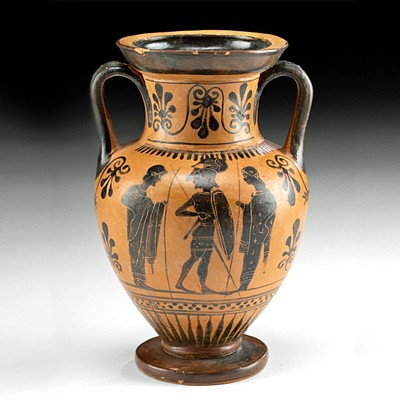Rare Ancient Amlash Bronze Primordial Bull Idol
Lot 89a
About Seller
Artemis Gallery
686 S Taylor Ave, Ste 106
Louisville, CO 80027
United States
Selling antiquities, ancient and ethnographic art online since 1993, Artemis Gallery specializes in Classical Antiquities (Egyptian, Greek, Roman, Near Eastern), Asian, Pre-Columbian, African / Tribal / Oceanographic art. Our extensive inventory includes pottery, stone, metal, wood, glass and textil...Read more
Categories
Estimate:
$6,000 - $8,000
Absentee vs Live bid
Two ways to bid:
- Leave a max absentee bid and the platform will bid on your behalf up to your maximum bid during the live auction.
- Bid live during the auction and your bids will be submitted real-time to the auctioneer.
Bid Increments
| Price | Bid Increment |
|---|---|
| $0 | $25 |
| $300 | $50 |
| $1,000 | $100 |
| $2,000 | $250 |
| $5,000 | $500 |
| $10,000 | $1,000 |
| $20,000 | $2,500 |
| $50,000 | $5,000 |
| $100,000 | $10,000 |
| $200,000 | $20,000 |
About Auction
By Artemis Gallery
Mar 9, 2023
Set Reminder
2023-03-09 10:00:00
2023-03-09 10:00:00
America/New_York
Bidsquare
Bidsquare : Exceptional Ancient, Ethnographic, & Fine Art
https://www.bidsquare.com/auctions/artemis-gallery/exceptional-ancient-ethnographic-fine-art-12354
Artemis Gallery info@artemisgallery.com
Artemis Gallery info@artemisgallery.com
- Lot Description
Near East / Central Asia, Northwestern Iran, Parthia / Amlash, late Bronze Age, ca. 1000 to 600 BCE. A remarkable bull effigy cast from bronze with a symmetrically proportioned body! Although hollow, no openings lead into the bull - a substantial bronze effigy figure with no obvious utilitarian function other than for use as a Zoroastrian or other religious offering; perhaps as an idol figure of Gavaevodata, a primordial bovine! Note the simplistic geometric forms throughout - cylindrical body and the emphasis on the crescent horns that invoke moon symbolism. Indeed, ancient Zoroastrian followers believed the earth rested on a rock carried by the Gavaevodata bull; when injured the lunar deity, Mah (Mangha), rescued and purified this primordial bull. Mah's crescent was part of the insignia for Parthian royalty as well. Besides use in religious myths, bulls were a recurring theme in near eastern art, most likely symbolizing the leader of the herd, that were known for strength and virility. Size: 8" L x 3.5" W x 7.75" H (20.3 cm x 8.9 cm x 19.7 cm)
Provenance: private Santa Fe, New Mexico USA collection acquired from Allan Davis, acquired before 2000
All items legal to buy/sell under U.S. Statute covering cultural patrimony Code 2600, CHAPTER 14, and are guaranteed to be as described or your money back.
A Certificate of Authenticity will accompany all winning bids.
We ship worldwide and handle all shipping in-house for your convenience.
#174772Repaired with restoration with new material to neck - professional and break line is nearly indiscernible. Surface abrasions, nicks, stable fissures on legs, and chips commensurate with age and exposure.. Heavy mineral encrustations and patina throughout out.Condition
- Shipping Info
-
All shipping is handled in-house for your convenience. Your invoice from Artemis Gallery will include shipping calculation instructions. If in doubt, please inquire BEFORE bidding for estimated shipping costs for individual items.
-
- Buyer's Premium



 EUR
EUR CAD
CAD AUD
AUD GBP
GBP MXN
MXN HKD
HKD CNY
CNY MYR
MYR SEK
SEK SGD
SGD CHF
CHF THB
THB













